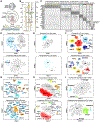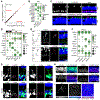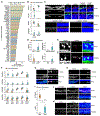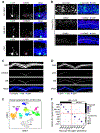Molecular Classification and Comparative Taxonomics of Foveal and Peripheral Cells in Primate Retina
- PMID: 30712875
- PMCID: PMC6424338
- DOI: 10.1016/j.cell.2019.01.004
Molecular Classification and Comparative Taxonomics of Foveal and Peripheral Cells in Primate Retina
Abstract
High-acuity vision in primates, including humans, is mediated by a small central retinal region called the fovea. As more accessible organisms lack a fovea, its specialized function and its dysfunction in ocular diseases remain poorly understood. We used 165,000 single-cell RNA-seq profiles to generate comprehensive cellular taxonomies of macaque fovea and peripheral retina. More than 80% of >60 cell types match between the two regions but exhibit substantial differences in proportions and gene expression, some of which we relate to functional differences. Comparison of macaque retinal types with those of mice reveals that interneuron types are tightly conserved. In contrast, projection neuron types and programs diverge, despite exhibiting conserved transcription factor codes. Key macaque types are conserved in humans, allowing mapping of cell-type and region-specific expression of >190 genes associated with 7 human retinal diseases. Our work provides a framework for comparative single-cell analysis across tissue regions and species.
Copyright © 2019 Elsevier Inc. All rights reserved.
Conflict of interest statement
COMPETING INTERESTS
AR is an equity holder in Celsius Therapeutics and an SAB member in Syros Pharmaceuticals and Thermo Fisher Scientific.
Figures







References
-
- Blanks JC, and Johnson LV (1984). Specific binding of peanut lectin to a class of retinal photoreceptor cells. A species comparison. Invest Ophthalmol Vis Sci 25, 546–557. - PubMed
-
- Bourne RR, Stevens GA, White RA, Smith JL, Flaxman SR, Price H, Jonas JB, Keeffe J, Leasher J, Naidoo K, et al. (2013). Causes of vision loss worldwide, 1990-2010: a systematic analysis. Lancet Glob Health 1, e339–349. - PubMed
-
- Bringmann A, Syrbe S, Gorner K, Kacza J, Francke M, Wiedemann P, and Reichenbach A (2018). The primate fovea: Structure, function and development. Prog Retin Eye Res. - PubMed
Publication types
MeSH terms
Grants and funding
LinkOut - more resources
Full Text Sources
Other Literature Sources
Medical
Molecular Biology Databases
Research Materials
Miscellaneous

